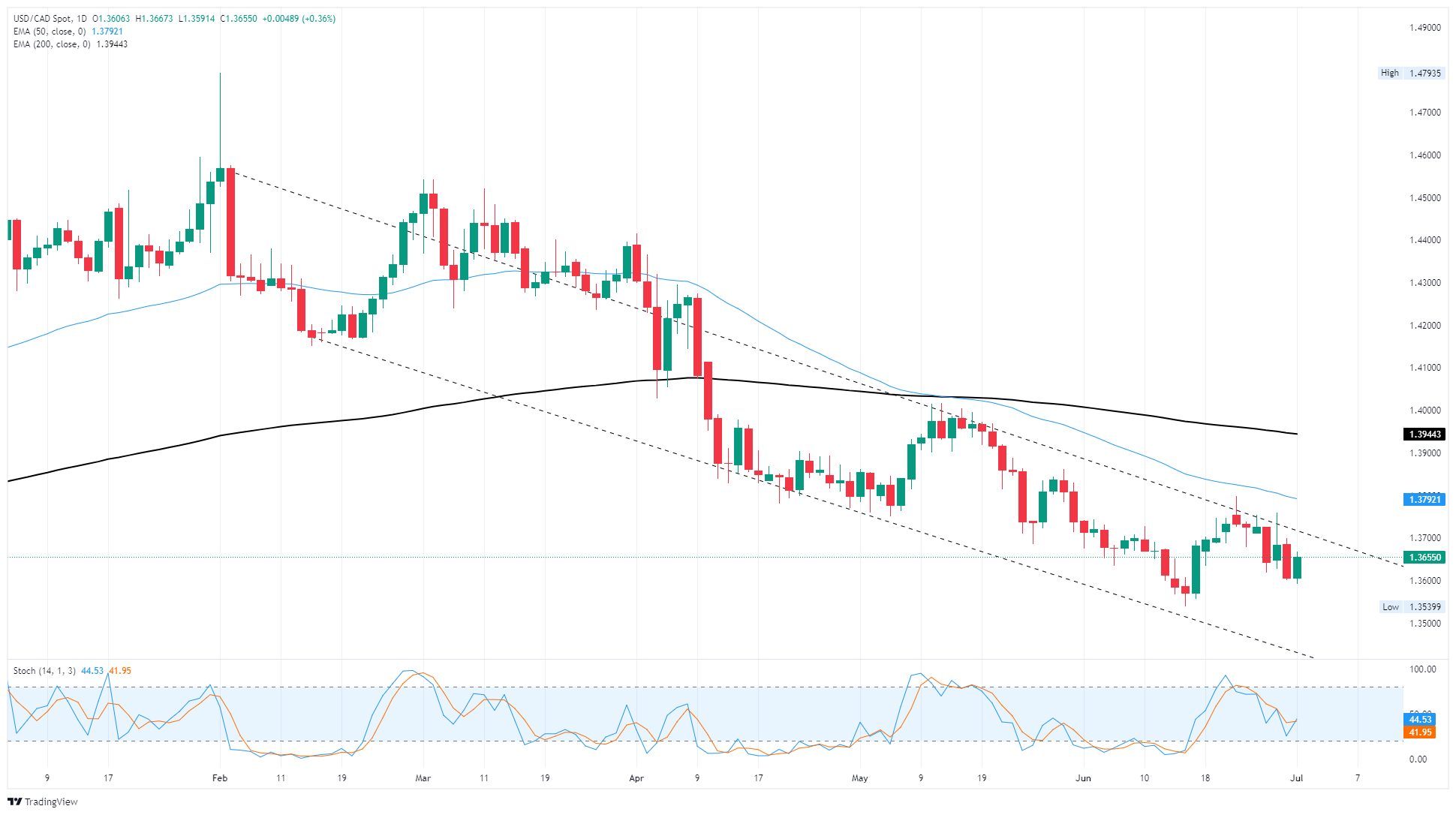Canadian Dollar pares gains on holiday-thinned Loonie markets
- The Canadian Dollar gave up near-term gains on Tuesday.
- Loonie markets are closed for the Canada Day holiday.
- US is poised to pass Trump budget bill, but roadblocks still remain.
The Canadian Dollar (CAD) pared away early-week gains on Tuesday, slipping back against the recovering US Dollar (USD) as Loonie traders take the day off in observance of the Canada Day national holiday. The rest of the week will be both volatile and short, with US Nonfarm Payrolls releasing a day early on Thursday and a US market holiday on the books for Friday.
The Loonie has been on a halting recovery swing against the Greenback in the near-term, but a deeply-battered US Dollar could be poised for a turnaround. Recent economic data from Canada will likely push the Bank of Canada (BoC) into a fresh batch of rate cuts, which could further weaken the Canadian Dollar and put USD/CAD on a path toward higher volatility as the two currencies race to the bottom.
Daily digest market movers: Loonie loses steam amid Canadian holiday
- The Canadian Dollar pared recent gains, falling back around one-third of one percent against the US Dollar on Tuesday.
- USD/CAD remains trapped below the 1.3700 handle as the Greenback weakens across the board, but markets could be poised for a turnaround with the Dollar Index (DXY) hanging around multi-year lows.
- Canadian markets are shuttered for a holiday on Tuesday, leaving USD/CAD at the mercy of US Dollar flows entirely.
- US Dollar strength is climbing as the US inches toward passing President Donald Trump’s deficit-swelling federal spending and budget bill, which will add trillions to the US’s federal deficit in the coming years.
- US NFP data will be landing a day early this week, scheduled for a Thursday release with US markets set to be closed for a national holiday on Friday.
Canadian Dollar price forecast
Despite near-term gains for the Loonie pushing USD/CAD down from its last swing high into 1.3800, CAD gains remain capped. The pair is still holding north of multi-month lows near 1.3550, but a snap in either direction could establish a new trend from here. Technical oscillators suggest the near-term bearish trend could still have some legroom, but Loonie bulls are struggling to keep USD/CAD falling from the 50-day Exponential Moving Average (EMA) near 1.3790.
USD/CAD daily chart

Canadian Dollar FAQs
The key factors driving the Canadian Dollar (CAD) are the level of interest rates set by the Bank of Canada (BoC), the price of Oil, Canada’s largest export, the health of its economy, inflation and the Trade Balance, which is the difference between the value of Canada’s exports versus its imports. Other factors include market sentiment – whether investors are taking on more risky assets (risk-on) or seeking safe-havens (risk-off) – with risk-on being CAD-positive. As its largest trading partner, the health of the US economy is also a key factor influencing the Canadian Dollar.
The Bank of Canada (BoC) has a significant influence on the Canadian Dollar by setting the level of interest rates that banks can lend to one another. This influences the level of interest rates for everyone. The main goal of the BoC is to maintain inflation at 1-3% by adjusting interest rates up or down. Relatively higher interest rates tend to be positive for the CAD. The Bank of Canada can also use quantitative easing and tightening to influence credit conditions, with the former CAD-negative and the latter CAD-positive.
The price of Oil is a key factor impacting the value of the Canadian Dollar. Petroleum is Canada’s biggest export, so Oil price tends to have an immediate impact on the CAD value. Generally, if Oil price rises CAD also goes up, as aggregate demand for the currency increases. The opposite is the case if the price of Oil falls. Higher Oil prices also tend to result in a greater likelihood of a positive Trade Balance, which is also supportive of the CAD.
While inflation had always traditionally been thought of as a negative factor for a currency since it lowers the value of money, the opposite has actually been the case in modern times with the relaxation of cross-border capital controls. Higher inflation tends to lead central banks to put up interest rates which attracts more capital inflows from global investors seeking a lucrative place to keep their money. This increases demand for the local currency, which in Canada’s case is the Canadian Dollar.
Macroeconomic data releases gauge the health of the economy and can have an impact on the Canadian Dollar. Indicators such as GDP, Manufacturing and Services PMIs, employment, and consumer sentiment surveys can all influence the direction of the CAD. A strong economy is good for the Canadian Dollar. Not only does it attract more foreign investment but it may encourage the Bank of Canada to put up interest rates, leading to a stronger currency. If economic data is weak, however, the CAD is likely to fall.
